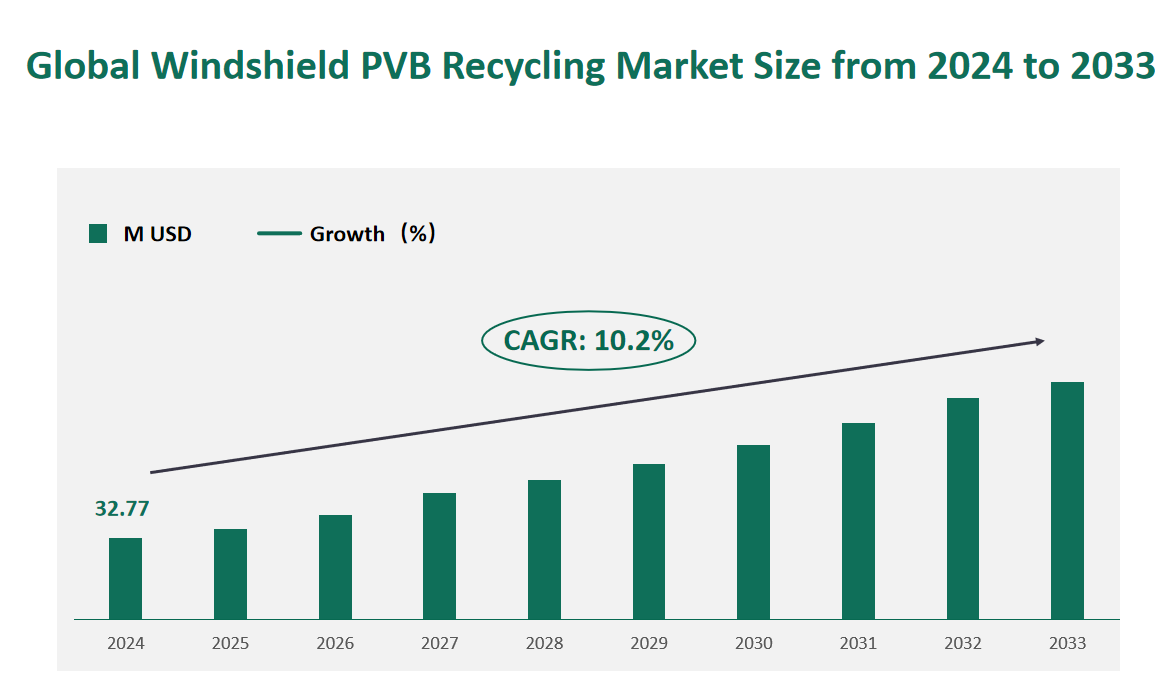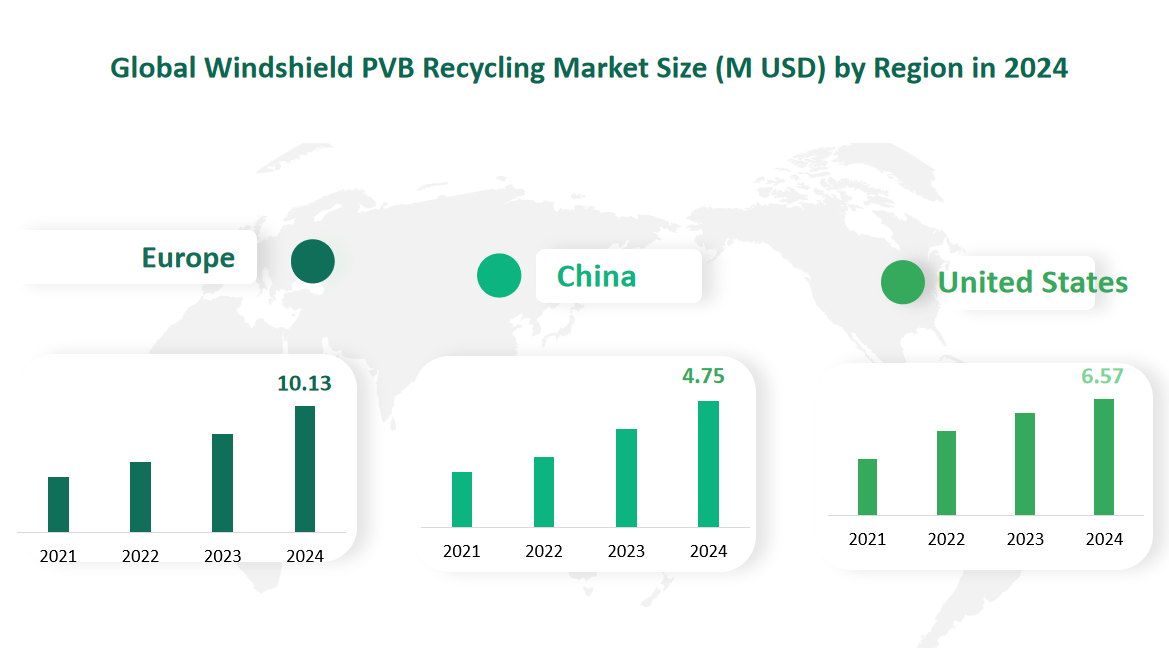1 Global Windshield PVB Recycling Market Size (Value) and CAGR (2024-2033)
In 2024, the global Windshield PVB Recycling market was valued at USD 32.77 million in 2024, with a CAGR of 10.2% from 2024 to 2033.
Windshield PVB Recycling refers to the process of recovering polyvinyl butyral (PVB) from end-of-life automotive windshields and repurposing it for various applications. PVB, a transparent polymer with excellent adhesive properties, is typically sandwiched between two layers of glass in laminated safety glass products, providing strength, impact resistance, and optical clarity. The recycling process not only reduces environmental pollution by diverting waste from landfills but also contributes to resource conservation by offering a secondary source of PVB for industries such as paints, textiles, and automotive parts.
Figure Global Windshield PVB Recycling Market Size (M USD) and CAGR 2024-2033

2 Windshield PVB Recycling Market Opportunities and Drivers
The Windshield PVB Recycling market is propelled by several key drivers and presents lucrative opportunities for growth. One of the primary drivers is the increasing demand for sustainable and environmentally friendly materials, which is accelerating the adoption of recycled PVB in various industries. The advantages of PVB glass, such as its high strength, toughness, and safety features, make it a preferred choice in automotive applications, thereby boosting the demand for Windshield PVB Recycling. The development of the automobile recycling industry, with its focus on circular economy practices, is another significant driver. This industry’s growth is supported by global initiatives to reduce hazardous materials in end-of-life vehicles and promote material recycling.
Opportunities in the Windshield PVB Recycling market are abundant, particularly with the rise in environmental trends and the need for energy conservation. The recycling process significantly reduces the need for energy-intensive glass manufacturing, conserves natural resources, and decreases landfill waste. Additionally, the increasing global production of electric vehicles in the Asia-Pacific region is expected to drive demand for automotive glass, creating new opportunities for Windshield PVB Recycling. The market is also set to benefit from the rising glass prices due to increased costs in energy and supply chain disruptions, making recycled PVB an economically viable alternative.
3 Windshield PVB Recycling Market Challenges and Restraints
Despite the promising outlook, the Windshield PVB Recycling market faces several challenges and restraints. Technical difficulties in the production process pose a significant challenge, as the separation of glass and PVB layers requires complex mechanical and chemical processes that can affect the performance of the recovered PVB. The industry also suffers from a lack of professionals with the specialized skills needed for the technical and production aspects of PVB recycling, hindering the industry’s growth and development.
Substitute barriers are another challenge, as alternatives like SGP and EVA compete with PVB in the market, potentially reducing the demand for Windshield PVB Recycling. SGP, known for its high strength and rigidity, and EVA, known for its cost-effectiveness, can limit the market share of PVB windshields. Furthermore, the market is affected by regional regulations that may impose restrictions or provide incentives for recycling, impacting the growth and adoption of Windshield PVB Recycling practices.
4 Global Windshield PVB Recycling Market Size and Share by Type in 2024
The Windshield PVB Recycling market is segmented by type, with each type serving distinct applications and possessing unique properties.
PVB particles: Estimated at USD 23.88 million in 2024, PVB particles are recycled from windshield and laminated glass. These particles are the result of a professional granulation process and are used in various applications due to their durability and performance. PVB particles are primarily used in the manufacturing of items such as paints, textile or leather coatings, paper barrier coatings, and anti-corrosion primers.
PVB powder: Projected to reach USD 6.35 million in 2024, PVB powder is generally a white, flowing powder that enhances the optical transparency and surface adhesion of products. It is commonly used as an additive for adhesives, providing improved bonding properties and clarity.
Table Global Windshield PVB Recycling Market Size and Share by Type in 2024
Type | Market Size (M USD) 2024 | Market Share |
PVB particles | 23.88 | 72.87% |
PVB powder | 6.35 | 19.36% |
Others | 2.54 | 7.76% |
5 Global Windshield PVB Recycling Market Size and Share by Application in 2024
The global Windshield PVB Recycling market is segmented into various applications, each playing a distinct role in the sustainable polymer industry.
Rubber Products: This application sector is expected to reach a market scale of USD 8.01 million in 2024. PVB recycling in rubber products is valued for its chemical corrosion resistance, precise melting point, and ease of molding. These characteristics make it an ideal material for a variety of rubber goods, contributing to the durability and longevity of rubber products.
Textile & Carpet: With a projected market scale of USD 14.52 million in 2024, PVB recycling in textiles and carpets enhances the durability of fabrics and provides excellent cushioning and support. This application leverages PVB’s ability to improve the performance and comfort of textile products.
Paint: The paint application is anticipated to have a market scale of USD 6.69 million in 2024. PVB in paint provides good adhesion for coatings, complements other adhesives, and offers additional functionalities such as anti-corrosion properties. This application capitalizes on PVB’s versatility in enhancing the performance of paint products.
Table Global Windshield PVB Recycling Market Size and Share by Application in 2024
Application | Market Size (M USD) 2024 | Market Share 2024 |
Rubber products | 8.01 | 24.44% |
Textile & Carpet | 14.52 | 44.30% |
Paint | 6.69 | 20.42% |
Others | 3.55 | 10.83% |
6 Global Windshield PVB Recycling Market Size by Region in 2024
The global Windshield PVB Recycling market exhibits regional diversity, with each area contributing to the market’s growth based on its unique economic and industrial conditions.
United States: With a market scale of USD 6.57 million in 2024, The region’s focus on sustainability and circular economy principles drives the demand for recycled PVB materials.
Europe: The European market is projected to reach USD 10.13 million in 2024. Europe’s commitment to sustainability is evident through its recycling legislation, which sets ambitious targets for recycling packaging waste, including PVB materials from windshields.
China: Expected to have a market scale of USD 4.75 million in 2024, China’s rapid industrialization and growing awareness of sustainable materials are driving the market. The country’s large automotive and construction sectors are significant consumers of recycled PVB products.
Japan: With a market scale of USD 2.96 million in 2024, Japan’s market is influenced by the country’s focus on technological innovation and environmental sustainability. Japan’s automotive and electronics industries are key drivers of the PVB recycling market.
Southeast Asia: Anticipated to reach a market scale of USD 1.83 million in 2024, Southeast Asia’s market is growing due to increasing industrialization and a shift towards sustainable practices, particularly in the automotive sector.
India: Projected to have a market scale of USD 1.91 million in 2024, India’s market is driven by its burgeoning economy and the growing demand for sustainable materials in various industries.
Latin America: With a market scale of USD 2.11 million in 2024, Latin America’s market is influenced by the region’s natural resource-based economy and the increasing adoption of recycling practices.
Middle East and Africa: Expected to contribute USD 1.78 million to the global market in 2024, these regions are witnessing growth due to increasing awareness of sustainable practices and the development of recycling infrastructure.
Figure Global Windshield PVB Recycling Market Size by Region in 2024

7 Major Players in Global Windshield PVB Recycling Market
7.1 Shark Solutions
Company Profile: Shark Solutions, established in 2005 and headquartered in Denmark, is a leading cleantech company that specializes in converting post-consumer PVB into advanced sustainable polymers for windshield and architectural glass recycling. The company primarily serves markets in Europe and North America.
Business Overview: Shark Solutions is recognized for its innovative approach to recycling laminated glass and car windshields, preventing them from ending up in landfills. The company has developed applications across various industries, including carpet backing, paints and coatings, sound insulation, and more.
Product Offered: The company’s flagship product, Mobile Shark Glass Separator, processes contaminants from glass, including PVB, palette, metal, rubber, silicone, and other compounds. This technology enables the efficient recycling of windshield PVB, contributing to a circular economy.
2022 Financials: In 2022, Shark Solutions reported a revenue of USD 8.68 million with a gross margin of 60.86%.
7.2 Dlubak Glass
Company Profile: Dlubak Glass, founded in 1932 and based in the USA, is a prominent player in the Windshield PVB Recycling market. The company’s primary focus is on providing clean and reusable glass to customers, with a strong presence in North America.
Business Overview: Dlubak Glass offers a range of services, including CRT Glass, Windshield Glass, Lighting Industry Glass, and PVB Extraction from Windshields. The company serves multiple industries, including automotive, CRT, lighting, sheet, fiberglass, container, and specialty glass.
Product Offered: Dlubak Glass’s product portfolio includes the extraction of PVB from windshields through mechanical crushing and processing to meet industry standards. This focus on quality and purity positions Dlubak Glass as a reliable supplier of PVB materials.
2022 Financials: Dlubak Glass achieved a revenue of USD 3.02 million in 2022, with a gross margin of 57.60%.
7.3 Saperatec GmbH
Company Profile: Saperatec GmbH, established in 2010 and headquartered in Germany, is a key player in the Windshield PVB Recycling market, primarily serving the European market.
Business Overview: Saperatec GmbH specializes in the recycling of various materials, including automotive glass. The company’s technology focuses on the separation and recycling of PVB from automotive glass, contributing to the overall recyclable materials management.
Product Offered: Saperatec GmbH’s core product involves the recycling of car glass, where the high-quality adhesive plastic film (PVB) is separated and reused, as well as the glass itself. This process is crucial for the company’s commitment to environmental sustainability.
2022 Financials: In 2022, Saperatec GmbH reported a revenue of USD 1.46 million, with a gross margin of 59.47%.

